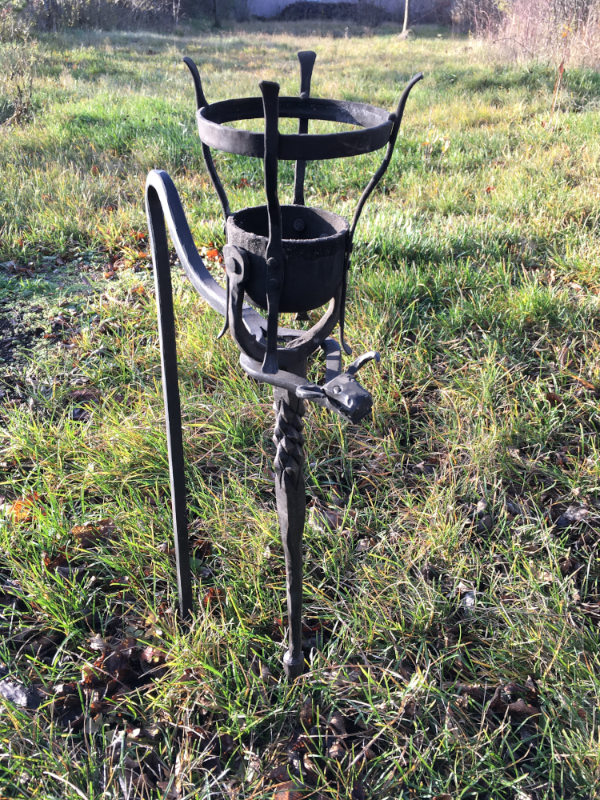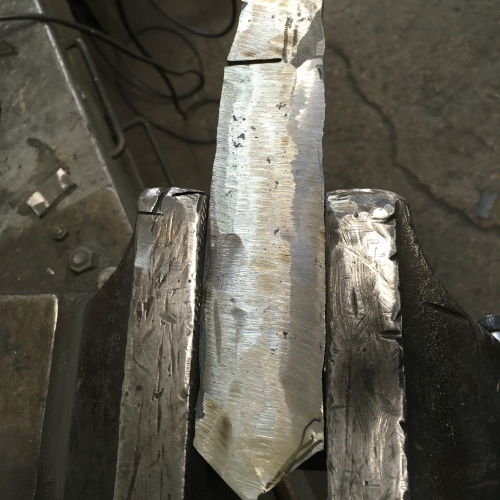Interning as a Blacksmith

Having spent so much time in Waltershausen (once as a butcher and twice as a baker), word had gotten out that there is an American interested in the trades and open to doing free internships. Friends of one of the butchers reached out and suggested that I learn a bit about their trades; namely, working as a carpenter and a blacksmith.
Being one more accustomed to working with my noggin, I was pretty sure that I was already stretching my capabilities being a baker and cheesemaker. Carpentry work did not appeal to me at all. And never in my life would I have actively sought out a blacksmith internship. However, I could never in my life turn down such an opportunity.

The blacksmith welcomed me graciously into his smithy. His nephew also worked there full-time, as his son decided that path was not for him – even after he became a journeyman. I was overwhelmed with the feel of testosterone in that place: the smell of oil, sulfur, and cold metal. The forge sat along the wall, and a row of hammers and tongs hung neatly in a rack surrounding it. Work-in-progress lay all about the workshop as well as unsold projects.
He had told me on the phone to wear old clothing as it would get burnt or dirty or ripped or all of the above. Regardless, he felt that my old clothing was still too new, so he lent me an old pair of pants and a jacket. He is much skinnier than I… the pants left little to the imagination.
His first assignment for me was to create a point out of an iron rod. This involved heating up the end, then hammering it into a point. I worked through four or so of them in about two hours. In that time, I had already developed a blister on my hammer hand from gripping the hammer incorrectly and too tightly.

We then worked on curving the iron using different parts of the anvil. One can easily assume that the anvil is so constructed on purpose; I guess I never cared to ask what those purposes were. There is a flat part for most hammering work, but the edges along the top vary from rounded to sharp – primarily for bending. There is a square hole and a round hole on top for various instruments that are all plug-and-play. Or one may use the whole to bend metal. The ‘spike’ on one end gives you an infinite number of circumferences for turns in the product.

In addition to the anvil work, there are many styles of hammers and tongs for metal working. I was taught that a master blacksmith often makes a set of thongs appropriate for a project before beginning a project. Furthermore, the construction of tongs is often used as a journeyman final exam.
Through this introduction to iron and hammering, I was able to create an S-hook with a beautiful twist in the middle. Think culdron hanging over a medieval fire; the iron S-hook would hold that handle. Additionally, he showed me with a bit more speed how one would could make a pretzel from iron. So, we worked together and ‘baked’ two iron pretzel on his forge.
Our project for the week, however, was constructing a Damascus steel knife. He explained that we would be taking two types of steel; one with more nickel and one with more manganese. We layered this in a first round of forging. We then cut it in two, forging the twelve layers together. We continued the second day until we had 108 layers; very similar, oddly enough, to the process of making croissants.
On the third day, I was asked to work on the handle – made from pear wood. It was at this time that he implied that the handle should fit my hand. He had intended to gift me the final result. For extremely obvious reasons, that would be impossible. I can accept a bread roll or a sausage after completing an internship, but a product that took a master tradesman a full week to complete… that is culturally unacceptable.
I also pitched in by grinding down and then smoothing the blade; using ever finer sand paper. The process was cumbersome, but the final product is beautiful.

He walked me through the various cooling and heating process that one must endure to make a strong, yet sharp blade. I had retold my understand from films: a smithy would forge a blade and then dip it into water (or salt water) and then the warrior would kill some foes. He laughed. We talked about hardening of metal versus cooling. Rapid cooling makes metal hard; slow cooling makes metal durable.
When the knife layers were complete, he cooled the blade extremely slowly as we still had to shape it and sharpen it. After that, he baked it at 200°C for two hours. Then we sharpened it further and I did my work in polishing it. Then we threw it back in the forge fire and brought it back to high heat. Finally, I was to cool it somewhat rapidly in used motor oil. If I was too slow to get the blade fully submerged, the top layer would ignite. Very exciting.
As a demonstration, he took some iron and created a sharp edge, then submerged it in water. He took his hammer and with one swing snapped off the blade. Then he repeated, but let it cool slowly, only dipping the very edge in water. This hardened the blade for long-term use, maintaining its sharpness, but allowed the rest of the blade to remain durable. Fascinating times at the blacksmith!
My final day there, he organized bratwurst for lunch. As I looked at the table, I could only feel pride. There were bratwurst from my internship as a butcher. There were bread rolls from my internship as a baker. And in order to cut open the rolls, we were using the knifes that I too had forged. It was a nice touch to have an iron pretzel as a side dish.





